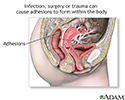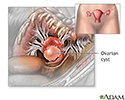Pelvic laparoscopy
Celioscopy; Band-aid surgery; Pelviscopy; Gynecologic laparoscopy; Exploratory laparoscopy - gynecologicPelvic laparoscopy is surgery to examine pelvic organs. It uses a viewing tool called a laparoscope. The surgery is also used to treat certain diseases of the pelvic organs.
-
Description
While you are deep asleep and pain-free under general anesthesia, the doctor makes a half-inch (1.25 centimeters) surgical cut in the skin below the belly button. Carbon dioxide gas is pumped into the abdomen to help the doctor see the organs more easily.
The laparoscope, an instrument that looks like a small telescope with a light and a video camera, is inserted so the doctor can view the area.
Other instruments may be inserted through other small cuts in the lower abdomen. While watching a video monitor, the doctor is able to:
- Get tissue samples (biopsy)
- Look for the cause of any symptoms
- Remove scar tissue or other abnormal tissue, such as from endometriosis
- Repair or remove part or all of the ovaries or uterine tubes
- Repair or remove parts of the uterus
- Do other surgical procedures (such as appendectomy, removing lymph nodes)
After the laparoscopy, the carbon dioxide gas is released, and the cuts are closed.
##RemoveMe##
-
Why the Procedure is Performed
Laparoscopy uses a smaller surgical cut than open surgery. This means your hospital stay is likely to be shorter and your recovery faster. There is less blood loss with laparoscopic surgery and less pain after surgery.
Pelvic laparoscopy is used both for diagnosis and treatment. It may be recommended for:
- An abnormal pelvic mass or ovarian cyst found using pelvic ultrasound
- Cancer (ovarian, endometrial, or cervical) to see if it has spread, or to remove nearby lymph nodes or tissue
- Chronic (long-term) pelvic pain, if no other cause has been found
- Ectopic (tubal) pregnancy
- Endometriosis
- Difficulty getting pregnant or having a baby (infertility)
- Sudden, severe pelvic pain
A pelvic laparoscopy may also be done to:
- Remove your uterus (hysterectomy)
- Remove uterine fibroids (myomectomy)
- "Tie" your tubes (tubal ligation/sterilization)
##RemoveMe##
-
Risks
Risks for any pelvic surgery include:
- Bleeding
- Blood clots in the leg or pelvic veins, which could travel to the lungs and, rarely, be fatal
- Breathing problems
- Damage to nearby organs and tissues
- Heart problems
- Infection
##RemoveMe##
-
Before the Procedure
Always tell your health care provider:
- If you are or could be pregnant
- What drugs you are taking, even drugs, herbs, or supplements you bought without a prescription
During the days before surgery:
- You may be asked to stop taking aspirin, ibuprofen (Advil, Motrin), warfarin (Coumadin), and any other drugs that make it hard for your blood to clot.
- Ask your provider which medicines you can still take on the day of your surgery.
- If you smoke, try to stop. Ask your provider for help.
- Arrange for someone to drive you home after surgery.
On the day of your surgery:
- You will usually be asked not to drink or eat anything after midnight the night before your surgery, or 8 hours before your surgery.
- Take the drugs your provider told you to take with a small sip of water.
- Your provider will tell you when to arrive at the hospital or clinic.
##RemoveMe##
-
After the Procedure
You will spend some time in a recovery area as you wake up from the anesthesia.
Many people are able to go home the same day as the procedure. Sometimes, you may need to stay overnight, depending on what surgery was done using the laparoscope.
The gas pumped into the abdomen may cause abdominal discomfort for 1 to 2 days after the procedure. Some people feel neck and shoulder pain for several days after a laparoscopy because the carbon dioxide gas irritates the diaphragm. As the gas is absorbed, this pain will go away. Lying down can help decrease the pain.
You will get a prescription for pain medicine or tell you what over-the-counter pain medicines you can take.
You may go back to your normal activities within 1 to 2 days. However, DO NOT lift anything over 10 pounds (4.5 kilograms) for 3 weeks after surgery to decrease your risk of getting a hernia in your incisions.
Depending on what procedure is done, you can usually begin sexual activities again as soon as any bleeding has stopped. If you have had a hysterectomy, you need to wait 3 months before having sexual intercourse again. Ask your provider what is recommended for the procedure you are having.
Call your provider if you have:
- Bleeding from the vagina
- Fever that does not go away
- Nausea and vomiting
- Severe abdominal pain
##RemoveMe##
References
Burney RO, Giudice LC. Endometriosis. In: Jameson JL, De Groot LJ, de Kretser DM, et al, eds. Endocrinology: Adult and Pediatric. 7th ed. Philadelphia, PA: Elsevier Saunders; 2016:chap 130.
Gaitán HG, Reveiz L, Farquhar C, Elias VM. Laparoscopy for the management of acute lower abdominal pain in women of childbearing age. Cochrane Database Syst Rev. 2014;(5):CD007683. PMID: 24848893 www.ncbi.nlm.nih.gov/pubmed/24848893.
Lentz GM. Endoscopy: Hysteroscopy and laparoscopy. In: Lentz GM, Lobo RA, Gershenson DM, Katz VL, eds. Comprehensive Gynecology. 6th ed. Philadelphia, PA: Elsevier Mosby; 2013:chap 10.
Ordon M, Eichel L, Landman J. Fundamentals of laparoscopic and robotic urologic surgery. In: Wein AJ, Kavoussi LR, Partin AW, Peters CA, eds. Campbell-Walsh Urology. 11th ed. Philadelphia, PA: Elsevier; 2016:chap 10.









